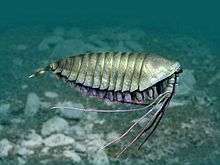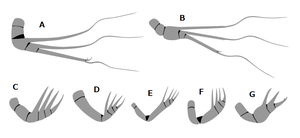Great appendage
Great appendages are claw-like appendages which attach to the heads of the "great appendage arthropods", a name usually refers to Megacheira, a class of extinct arthropod characterized by a pair of "short-great appendages" bearing in front of the animal's head.[1]


In general, megacheiran's great appendage have 6 segments, with the promixal two segments forming a peduncle and the finger-like distal four segments forming a claw, both connect by an elbow joint.[2] Great appendages are interpret as raptorial limbs involved in predation, with those of some genus such as Yohoia are structurally comparable to the raptorial maxillipeds of mantis shrimp.[2] While the great appendages of leanchoilid megacheirans such as Leanchoilia and Yawunik have elongated flagella, suggest a sensory role alongside predatory function.[3]

Radiodont's frontal appendages have controversial relationships to those of the megacheirans. They have been suggested to be homologous with the antennule of the euarthropods,[4] or the chelicerae of chelicerates,[2][5] although the latter possibility had been discounted by some authors.[6][7] Later observations reject the homology of this two type of "great appendages", with neural structures clarifying the segmental affinities of radiodont frontal appendages as protocerebral (homologous to euarthropod's labrum),[8] and megacheiran's short-great appendages as deutocerebral (homologous to euarthropod's antennule and chelicerae).[1] Similar appendages also found in other Cambrian arthropods such as Isoxys and Occacaris, but their segmental affinities remain conjectural.[1] On the other hand, a 2020 study suggested that the great/frontal appendages of Megacheirans, Isoxyids and Radiodontans to be homologous, and that the presence of a great appendage is the ancestral condition for Euarthropoda.[9]
References
- Ortega-Hernández, Javier; Janssen, Ralf; Budd, Graham E. (2017-05-01). "Origin and evolution of the panarthropod head – A palaeobiological and developmental perspective". Arthropod Structure & Development. Evolution of Segmentation. 46 (3): 354–379. doi:10.1016/j.asd.2016.10.011. ISSN 1467-8039. PMID 27989966.
- Haug, Joachim T.; Waloszek, Dieter; Maas, Andreas; Liu, Yu; Haug, Carolin (March 2012). "Functional morphology, ontogeny and evolution of mantis shrimp-like predators in the Cambrian: MANTIS SHRIMP-LIKE CAMBRIAN PREDATORS". Palaeontology. 55 (2): 369–399. doi:10.1111/j.1475-4983.2011.01124.x.
- Aria, Cédric; Caron, Jean-Bernard; Gaines, Robert (2015). "A large new leanchoiliid from the Burgess Shale and the influence of inapplicable states on stem arthropod phylogeny". Palaeontology. 58 (4): 629–660. doi:10.1111/pala.12161.
- Stein, Martin (2010). "A new arthropod from the Early Cambrian of North Greenland, with a 'great appendage'-like antennula". Zoological Journal of the Linnean Society. 158 (3): 477–500. doi:10.1111/j.1096-3642.2009.00562.x.
- Dornbos, Stephen; Bottjer, David; Chen, Jun-Yuan (2004). "Evidence for seafloor microbial mats and associated metazoan lifestyles in Lower Cambrian phosphorites of Southwest China" (PDF). Lethaia. 37 (2): 127–137. doi:10.1080/00241160410004764.
- Jager, Muriel; Murienne, Jérôme; Clabaut, Céline; Deutsch, Jean; Le Guyader, Hervé; Manuel, Michaël (2006). "Homology of arthropod anterior appendages revealed by Hox gene expression in a sea spider". Nature. 441 (7092): 506–508. Bibcode:2006Natur.441..506J. doi:10.1038/nature04591. PMID 16724066.
- Myers, PZ (May 26, 2006). "Chelifores, chelicerae, and invertebrate evolution". Pharyngula.
- Peiyun Cong; Xiaoya Ma; Xianguang Hou; Gregory D. Edgecombe; Nicholas J. Strausfeld (2014). "Brain structure resolves the segmental affinity of anomalocaridid appendages". Nature. 513 (7519): 538–42. doi:10.1038/nature13486. PMID 25043032.
- Aria, Cédric; Zhao, Fangchen; Zeng, Han; Guo, Jin; Zhu, Maoyan (December 2020). "Fossils from South China redefine the ancestral euarthropod body plan". BMC Evolutionary Biology. 20 (1): 4. doi:10.1186/s12862-019-1560-7. ISSN 1471-2148. PMC 6950928. PMID 31914921.